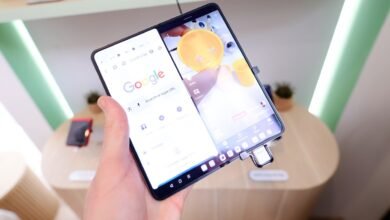Revolutionary Design Boost in iPhone 17 Pro Might Skyrocket Your Signal Strength!

The iPhone 17 Pro’s Major Design Change Could Enhance Cellular Reception
The iPhone 17 Pro is turning heads not just because of its sleek aesthetics and impressive specs, but also due to some significant design changes aimed at improving cellular reception. Apple has always strived to enhance user experiences, and with the latest iteration of their flagship smartphone, they are addressing a common pain point: poor signal strength. In this blog post, we will delve into the details surrounding these design modifications, how they are expected to enhance cellular connectivity, and what this means for iPhone users moving forward.
A Shift in Design Philosophy
Apple’s design philosophy has undergone notable changes over the years. With the iPhone 17 Pro, engineers have prioritized making one of the most crucial aspects of a smartphone—the quality of its cellular connection—a primary focus in the design process. Historically, smartphones have struggled to maintain optimal cellular reception, especially in urban areas crowded with large buildings or in remote locations where signals can weaken significantly.
The iPhone 17 Pro introduces a redesigned antenna system that is reportedly placed more strategically within the phone’s frame. This innovative design aims to reduce signal interference and enhance connectivity, especially in challenging environments. The antenna layout has been revised to optimize signal reception, allowing the device to pick up cellular signals more effectively than its predecessors.
Technical Innovations Behind the Antenna Design
The technical advancements behind the iPhone 17 Pro’s antenna system are worth noting. Apple has integrated new materials and configurations that help to improve the overall performance of the cellular antennas. The placement of these antennas has also been optimized within the device’s chassis, minimizing the obstructions that can block radio signals.
One of the significant changes is a switch to a hybrid antenna design that combines both metal and plastic elements. Traditionally, smartphones relied heavily on metal components which could interfere with the cellular signals. By using plastic in tandem with metal, Apple has succeeded in creating an antenna system that strikes a balance between aesthetics and functionality.
Real-World Testing and User Feedback
As the iPhone 17 Pro hits the market, real-world tests have begun to accumulate, providing valuable insights into the effectiveness of these design changes. Early reports from users have indicated a noticeable improvement in cellular reception in areas that previously posed a challenge. Whether in densely populated cities or rural regions with patchy service, many iPhone 17 Pro users are finding that their connectivity remains stronger and more reliable.
Moreover, several independent reviews conducted by tech enthusiasts have confirmed these findings. Users noted that making calls, sending text messages, and accessing mobile data were significantly more reliable compared to earlier models. This improvement in connectivity can be attributed to the combined effects of the new hybrid antenna design and the strategic placement within the iPhone 17 Pro’s body.
The Impact of 5G Technology
With the transition to 5G technology, the need for enhanced cellular reception has become even more critical. 5G networks offer faster data speeds and lower latency, but they also require a more robust and efficient signal to operate effectively. The iPhone 17 Pro’s advancements are particularly timely, as consumers seek devices capable of taking full advantage of the new generation of telecommunications.
The improvements in the antenna design also align perfectly with the increased demands of 5G networks, which can struggle with interference that older technology was more forgiving of. The upgraded configurations used in the iPhone 17 Pro are designed to handle the unique challenges posed by 5G, enabling the device to maintain stable and speedy connections even in less than ideal conditions.
Considerations for the Future
As smartphone technology continues to evolve, we can expect that connectivity improvements will remain a top priority for manufacturers. Apple’s proactive approach with the iPhone 17 Pro sets a precedent for future designs that prioritize reception improvements. The changes introduced may well influence competitors to explore similar enhancements in their devices to remain competitive in a market where user experience is paramount.
Additionally, Apple is expected to continue testing and refining their designs based on feedback and technological advancements. With consumer connectivity needs evolving along with the technology itself, Apple’s commitment to addressing these challenges suggests that future iPhone models will continue to integrate improvements related to cellular reception.
Conclusion
The iPhone 17 Pro’s innovative approach towards improving cellular reception is not just a cosmetic change; it is a thoughtful re-engineering aimed at enhancing user experience in crucial areas of connectivity. By embracing a hybrid antenna design, strategically optimizing the layout, and keeping pace with emerging 5G technology, Apple is setting a new standard that promises to deliver improved connectivity to users around the globe. As users continue to adapt to evolving technology and connectivity expectations, the iPhone 17 Pro exemplifies how design innovation can address real-world challenges effectively.
The iPhone 17 Pro is a significant step forward in ensuring that users can rely on their devices for seamless communication, regardless of where they are. As the smart device landscape continues to evolve, Apple’s efforts in this area will likely influence other manufacturers and shape the future of smartphone connectivity.
Summary
- The iPhone 17 Pro features significant design changes to improve cellular reception.
- Apple’s new antenna system aims to reduce signal interference and enhance connectivity.
- Real-world tests have shown improved cellular reception in challenging environments.
- The advances are timely, coinciding with the rollout of 5G technology.
- Future device designs may follow suit in integrating better connectivity solutions.





